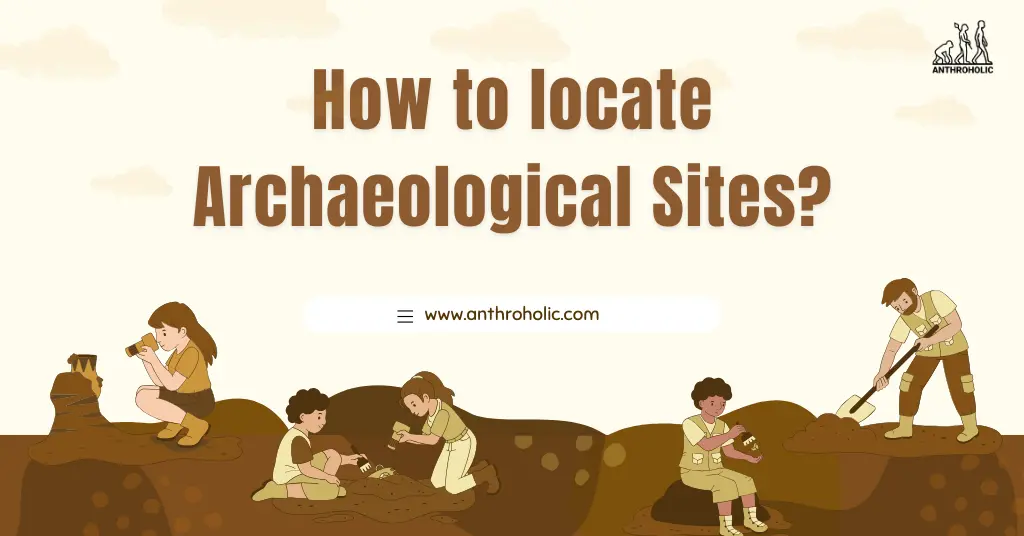AI Answer Evaluation Platform Live Now. Try Free Answer Evaluation Now
How to Locate Archaeological Sites?
The quest to locate archaeological sites is a fascinating journey through history and technology. It combines the detective work of piecing together historical clues with cutting-edge scientific methods to uncover the secrets of the past. Locating these sites involves a multidisciplinary approach, where archaeologists, historians, and scientists collaborate to unravel the stories buried beneath our feet. From scrutinizing ancient texts and maps to deploying advanced remote sensing technologies like LIDAR and Ground Penetrating Radar, the process is as intricate as it is thrilling.

Historical Research and Initial Planning
The first step in discovering archaeological sites is comprehensive historical research and careful initial planning. This phase lays the groundwork for fieldwork and is crucial for identifying potential locations of archaeological significance.
Understanding the Past
- Literature Review: This involves an in-depth study of historical records, academic papers, and ancient texts. Researchers look for references to old settlements, battles, or significant events that might indicate the presence of an archaeological site.
- Sources: Historical books, scholarly articles, ancient manuscripts, and travel diaries.
- Objective: To gather clues about the location and context of potential sites.
- Local Knowledge: Engaging with local communities, especially indigenous populations, can provide invaluable insights. Oral histories and traditional stories often contain information not found in written records.
- Interviews: Talking to local elders and community leaders.
- Field Notes: Documenting local legends and folklore.
Technology in Research
- Databases and Archives: Digital archives and historical databases offer a wealth of information. These can include old land registers, census data, and previously recorded archaeological findings.
- Online Libraries: Access to digital copies of rare texts and documents.
- Archaeological Databases: Information on past excavations and findings.
- GIS Mapping: Geographic Information Systems are used to analyze spatial and geographic data. GIS can reveal changes in landscape, land use patterns, and other clues indicative of historical sites.
- Overlay Techniques: Comparing modern maps with historical ones to identify changes or anomalies.
- Terrain Analysis: Understanding the geographical features that might have influenced ancient settlements.
Pre-Survey Analysis
- Site Selection Criteria: Based on the research, archaeologists develop criteria for selecting potential sites. This includes accessibility, historical significance, and likelihood of finding artifacts.
- Initial Hypotheses: Formulating hypotheses about what might be found at each potential site. These hypotheses guide the initial phases of fieldwork.
Collaboration and Networking
- Working with Historians and Experts: Collaboration with historians, archaeologists, and other experts in the field is essential. They can provide specialized knowledge and insights.
- Academic and Research Institutions: Establishing connections with universities and research institutions can provide access to resources and expertise.
This phase is critical as it sets the foundation for the practical exploration of archaeological sites. It requires a multidisciplinary approach, combining historical knowledge with modern technology and methodologies.
Field Methods in Archaeology
Once historical research and initial planning have pinpointed potential archaeological sites, the next step involves a range of field methods. These methods are designed to validate the initial research, locate artifacts, and understand the context of the site.
Remote Sensing Techniques
These non-invasive techniques allow archaeologists to explore potential sites without disturbing the ground.
- Aerial Photography: This is one of the oldest forms of remote sensing used in archaeology. It involves taking photographs from airplanes or drones to identify site anomalies, such as unusual earthworks or vegetation patterns.
- Types: Oblique (angled) and vertical photography.
- Uses: To identify features like ancient roadways, building foundations, and burial sites.
- LIDAR (Light Detection and Ranging): LIDAR uses laser light to map the ground surface with high precision. It is particularly useful in areas with dense vegetation where surface features are not easily visible.
- Capabilities: Penetrates vegetation to reveal ground features.
- Applications: Used extensively in discovering hidden Mayan cities and other obscured sites.
- Ground Penetrating Radar (GPR): GPR sends radio waves into the ground and measures their reflection to detect buried structures or artifacts.
- Depth: Can penetrate several meters, depending on soil conditions.
- Details: Reveals the size, depth, and material properties of subsurface features.
Ground Surveys
Ground surveys are hands-on methods for exploring potential archaeological sites.
- Walkover Surveys: Teams of archaeologists systematically walk over a landscape, looking for visible signs of past human activities, such as stone tools, pottery shards, or building remains.
- Recording: Findings are mapped and documented for further analysis.
- Efficiency: Covers large areas in a relatively short time.
- Test Pits: Small pits are dug at regular intervals across a site to examine soil layers and search for artifacts.
- Sampling: Provides a cross-section of archaeological deposits.
- Stratigraphy Analysis: Helps understand the chronological sequence of human activity.
Excavation Techniques
When a site shows promise, more invasive techniques such as excavation are employed.
- Grid System: Excavation sites are divided into grids to keep track of where artifacts are found.
- Documentation: Each grid is carefully excavated, with all findings recorded and mapped.
- Stratigraphy: The layers of soil are removed methodically to preserve the chronological context.
- Contextual Analysis: Artifacts are analyzed in relation to each other and to the layers of soil in which they are found.
- Purpose: To reconstruct the past human activities and understand the site’s history.
Post-Fieldwork Analysis
- Laboratory Analysis: Artifacts are cleaned, categorized, and studied in detail.
- Data Interpretation: Combines findings from the field with historical research to formulate a comprehensive understanding of the site.
Ethical Considerations
- Site Preservation: Every effort is made to preserve the integrity of the site.
- Repatriation and Cultural Sensitivity: Artifacts are treated with respect, particularly those with cultural or religious significance.
Field methods in archaeology are diverse and adaptable, combining traditional techniques with modern technology to uncover the secrets of the past. They require careful planning, meticulous execution, and a deep respect for the historical and cultural contexts of the findings.

Legal and Ethical Considerations
In the field of archaeology, legal and ethical considerations are paramount. They ensure that archaeological practices respect both the law and the cultural heritage they seek to study. This section delves into these crucial aspects.
Legal Frameworks and Permissions
Archaeological work often involves navigating complex legal landscapes.
- Government Permits: Before any excavation or exploration can begin, it’s essential to obtain the necessary permits from relevant local, regional, or national authorities. These permits regulate what can be done at archaeological sites.
- Application Process: Involves submitting detailed project proposals to the appropriate authorities.
- Legal Compliance: Ensures that the project abides by national and international laws protecting cultural heritage.
- International Conventions: There are several international treaties and conventions, like the UNESCO World Heritage Convention, that set out guidelines for the protection and preservation of cultural heritage.
- Purpose: To prevent illicit trafficking of cultural objects and ensure the ethical treatment of archaeological findings.
Ethical Considerations
Ethical practices in archaeology go beyond legal obligations, focusing on respecting the cultural and historical significance of sites and artifacts.
- Respect for Indigenous and Local Communities: Many archaeological sites hold great cultural, spiritual, or historical significance to local or indigenous communities.
- Engagement and Consent: Actively engaging with these communities and seeking their consent and involvement in the project.
- Cultural Sensitivity: Understanding and respecting the cultural values and traditions associated with the site.
- Non-Invasive Techniques: Wherever possible, archaeologists use non-invasive or minimally invasive techniques to avoid damaging the site.
- Remote Sensing and Surveys: Preferred over full-scale excavations to preserve the site’s integrity.
Artifact Preservation and Management
The handling, storage, and display of artifacts are covered by both legal and ethical guidelines.
- Artifact Care: Ensuring that all artifacts are carefully preserved and documented.
- Public Display and Access: Balancing the need for public access and education with the respect and care for the artifacts.
- Repatriation: In cases where artifacts are found to have been taken improperly, there is a growing movement towards repatriation, returning them to their country or community of origin.
Collaboration with Authorities
Cooperation with local, national, and international authorities is crucial for the legal and ethical conduct of archaeological work.
- Reporting Findings: All significant findings are reported to the appropriate authorities.
- Collaborative Projects: Often, archaeological projects involve collaboration between international teams and local authorities or institutions.
Environmental Considerations
Archaeological excavations can have an impact on the environment, which needs to be minimized.
- Site Restoration: After excavation, efforts are made to restore the site to its original condition as much as possible.
- Sustainable Practices: Employing methods that have the least environmental impact.
Case Studies
| Region | Method Used | Discovery |
|---|---|---|
| Egypt | LIDAR | New Pharaonic tombs |
| Mexico | Aerial Photography | Mayan Temples |
| China | Local Knowledge | Ancient village site |
Conclusions and Future Directions
The search for archaeological sites is an evolving field, blending traditional techniques with cutting-edge technology. The key to success lies in respectful and meticulous research, combined with a deep understanding of the laws and cultural significance of potential sites.




